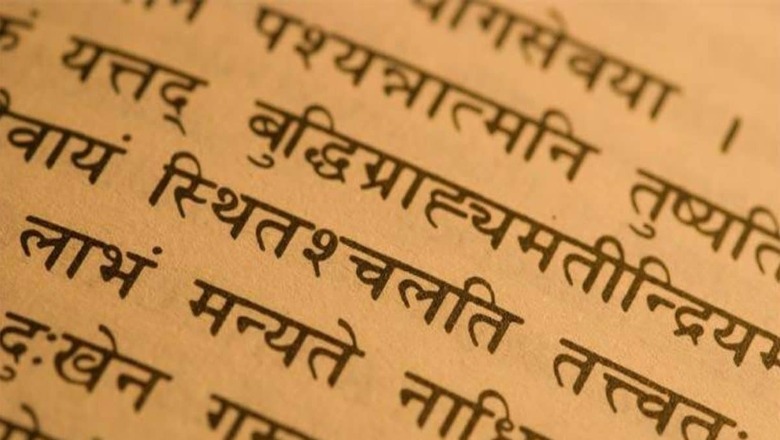
views
Even as the Dravidianists were busy chopping off the ancient and unbroken Sanatana roots in Tamil Nadu with each successive decade, the larger society was somehow trying to grasp onto whatever remained of that hoary legacy.
Dr B.G.L. Swamy — the son of illustrious journalist, freedom fighter, philosopher and litterateur D.V. Gundappa — served for more than two decades in the prestigious Presidency College, Madras, first as Botany professor and then as Principal. In a series of memoirs of his professional life (written in Kannada), he has provided vivid, eye-opening and eyewitness accounts of the scene of that period. It has all the markers of an epic tragedy interspersed with cruel irony.
Swamy observes how even in the 1940s, the Sanskrit department of the Presidency College comprised students who studied B.A. and M.A. in the same classes irrespective of caste, class, and religious differences. However, this harmony would be systematically erased within a decade in direct proportion to the growth of Dravidian political power.
One of the prefaces to this erasure is available in the form of a letter written by a Dravidianist named V. Radhakrishnan in July 1951. Here’s how it reads: “When a well-exploited language like Sanskrit is helped in such a generous manner as the rewarding of rich scholarships and substantial grants, surely Tamil, the language of the land, Tamil, the only hope for the reconstruction of South Indian History, deserves better treatment. Sanskrit…is a dead language good only for keeping the Brahmans in power.”
As we shall see, this theme of supremacy of the Tamil language was premised on the massacre of Sanskrit. It unfolded in a deplorable and tragic manner.
Those familiar with Arun Shourie’s classic expose of Marxist misdeeds in his Eminent Historians will also be familiar with a phrase in that book: Shuddho-Ashuddho!
That was the constant refrain in a circular issued by the Education Department of the Jyoti Basu government in 1989 about the proposed changes in the history syllabus in the state. This is the summary of the Shuddho-Ashuddho doctrine: all mentions of Muslim atrocities against Hindus during the period of Islamic rule were recast as Ashuddho (literally, impure) and had to be deleted; all mentions of the brave Hindu kings and warriors who resisted them were also Ashuddho. The converse was also true — i.e., it was Shuddho. This was how tolerance and sainthood were bestowed upon every Muslim despot, starting from Mahmud of Ghazni all the way up to Aurangzeb and Tipu.
But the Communists in West Bengal were at least three decades late to the game.
The Dravidianists had implemented the Shuddho-Ashuddho doctrine as early as the 1950s itself in Tamil Nadu, by labelling the deva bhasha, Sanskrit, as Ashuddho. The pristine “purity” of the Dravidian version of Tamil, like the jealous Abrahamic Gods, wouldn’t tolerate an equal, and therefore commanded a wholesale slaughter of Sanskrit.
It is one thing to simply read historical or contemporary records of wars and other tragedies. However, it is entirely a different thing to actually live or experience those horrors. Which is why our wise men and women from ancient times issued this eternal caution: Yuddhasya vaartaa ramyaa — i.e., only the narrative or story of a war is thrilling. What was left unsaid but implied was that direct experience of, or participation in war, was anything but thrilling.
We notice a similar phenomenon unfolding with the Dravidianists. By the second half of the 1950s, the frenzied activism of the Dravidianists, whose toxic Tamil linguistic chauvinism had penetrated almost every corner of Tamil society, was about to hit the climax they desired. They were now within striking distance of capturing political power, which alone would enable them to seize and bamboozle institutions with the Dravidian battering ram. Several acclaimed Tamil movies — including Mani Ratnam’s Iruvar — depict this bamboozling as some sort of Dravidian deliverance of Tamil Nadu, which ushered in equality and social justice.
However, its real-life consequences were anything but equal or just. As Dr B.G.L. Swamy describes, the atmosphere of social harmony that had existed among the B.A. and M.A. students at Presidency College, Madras, until the late 1940s was shattered by a series of venal steps directly aimed at destroying Sanskrit in the garb of making it more accessible to the masses.
It all began with a self-righteous demand for… justice. This demand was rooted — both in theory and practice — in the manufactured Dravidian victimhood narrative. Overnight, someone miraculously “noticed” that a majority of students graduating with first-class marks belonged only to a “particular forward caste”. This “observation” was followed by this demand: “A scheme should be devised whereby other castes should also be given first-class marks,” to quote Dr Swamy.
The matter was hotly debated for weeks in the University Senate and the Rajya Sabha. The “warrior” Dravidian (Veera Dravida) and “pure” Tamil tabloids witnessed record sales propagandising this canard. As we’ve seen earlier in this essay series, the Dravidian rabble-rousers won the day on this occasion as well. A new precedent and rule was devised as a result of this victorious propaganda. Henceforth, Sanskrit examiners were to be appointed solely on the basis of their caste.
What happened next will be narrated in the next and concluding installment of this series.
(To be continued)
The author is the founder and chief editor, The Dharma Dispatch. Views expressed in the above piece are personal and solely that of the author. They do not necessarily reflect News18’s views.


















Comments
0 comment